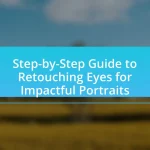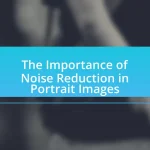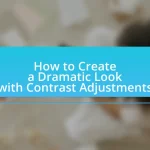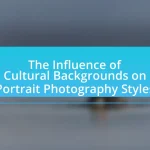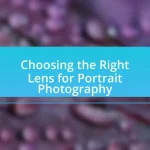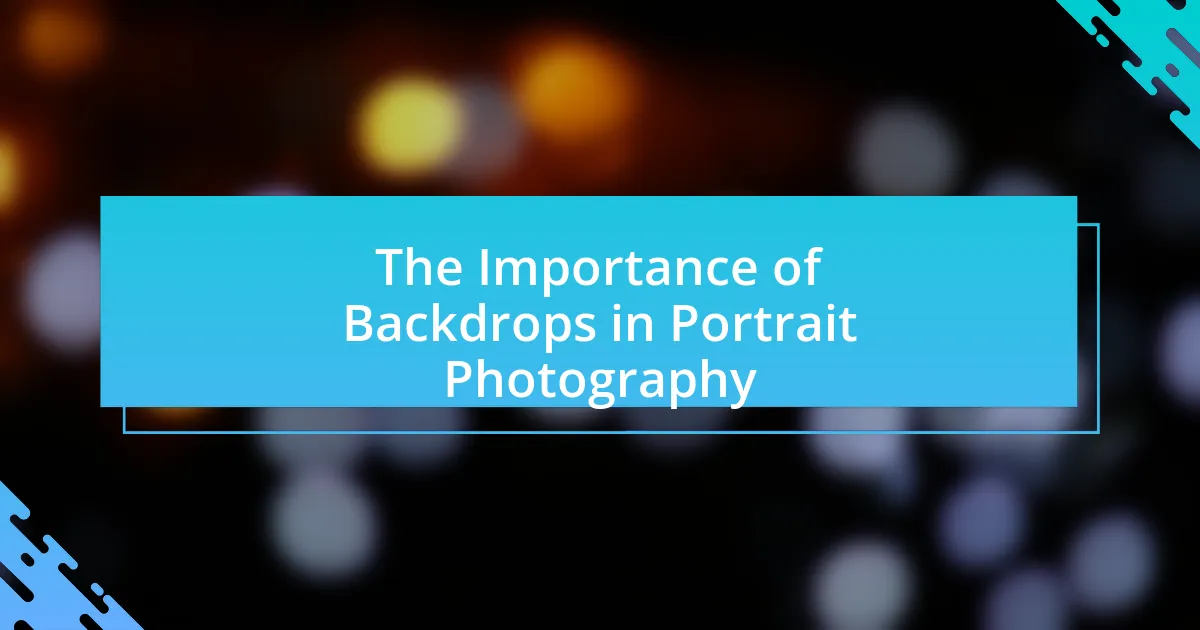Essential props play a crucial role in enhancing portrait photography by adding visual interest, context, and emotional depth to the subject. Commonly used props include hats, scarves, flowers, and personal items, which can convey personality and tell a story. The article explores how props influence composition, evoke emotions, and assist in storytelling, while also providing guidance on selecting appropriate props that align with the subject’s personality and the overall theme of the shoot. Additionally, it addresses best practices for integrating props effectively to create engaging and memorable portraits.
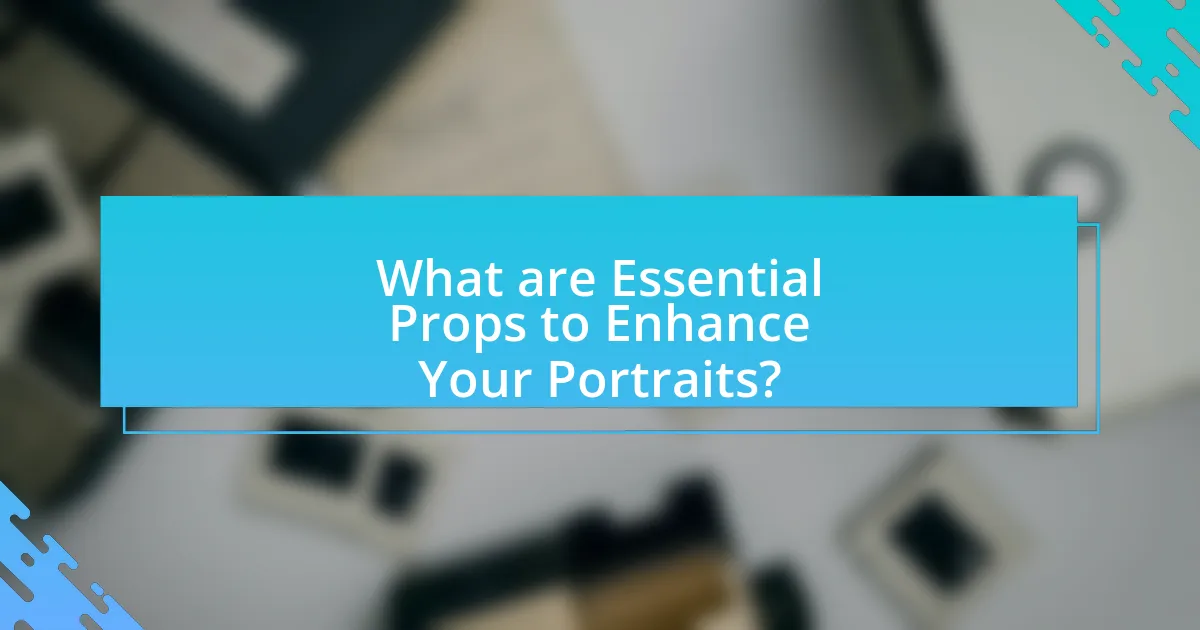
What are Essential Props to Enhance Your Portraits?
Essential props to enhance your portraits include items such as hats, scarves, and flowers, which add visual interest and personality to the subject. These props can create context, evoke emotions, and help tell a story within the portrait. For instance, using a hat can introduce a sense of style or character, while flowers can symbolize beauty or fragility. Studies in photography emphasize that incorporating props can significantly improve the composition and engagement of portraits, making them more memorable and impactful.
How do props influence the overall composition of a portrait?
Props significantly influence the overall composition of a portrait by adding context, depth, and narrative elements that enhance the subject’s story. They can create visual interest, guide the viewer’s eye, and establish a mood or theme, thereby enriching the viewer’s experience. For instance, a musician holding an instrument not only highlights their profession but also evokes emotions associated with music, making the portrait more engaging. Studies in visual arts emphasize that well-chosen props can balance the composition and draw attention to the subject, reinforcing the intended message of the portrait.
What types of props can be used to convey different emotions in portraits?
Various types of props can be used to convey different emotions in portraits, including personal items, natural elements, and symbolic objects. Personal items, such as a favorite book or a piece of jewelry, can evoke nostalgia or intimacy, while natural elements like flowers or leaves can express tranquility or vibrancy. Symbolic objects, such as masks or instruments, can represent identity or passion, effectively enhancing the emotional depth of the portrait. Research indicates that the inclusion of props can significantly influence the viewer’s perception of the subject’s emotions, as demonstrated in studies on visual storytelling in photography.
How do props help in storytelling within portrait photography?
Props enhance storytelling within portrait photography by providing context and depth to the subject’s narrative. They can symbolize emotions, interests, or aspects of the subject’s life, thereby creating a more engaging visual story. For instance, a musician holding an instrument conveys passion and identity, while a book can suggest intellect or a love for literature. This use of props not only enriches the composition but also invites viewers to interpret the subject’s story more deeply, making the portrait more relatable and memorable.
Why are props important in portrait photography?
Props are important in portrait photography because they enhance the visual storytelling and add context to the subject. By incorporating props, photographers can create a more engaging narrative that reflects the personality or interests of the subject, making the portrait more relatable and dynamic. For instance, a musician holding an instrument or an artist surrounded by their tools can convey their identity more effectively. Studies in visual communication indicate that props can significantly influence the viewer’s perception and emotional response, thereby enriching the overall impact of the portrait.
What role do props play in enhancing the subject’s personality?
Props play a crucial role in enhancing a subject’s personality by providing context and visual interest that reflects their character. When integrated thoughtfully, props can symbolize the subject’s interests, profession, or personal story, thereby adding depth to the portrayal. For instance, a musician holding an instrument not only showcases their talent but also conveys their passion and lifestyle, making the personality more relatable and engaging to the viewer. Research indicates that visual elements, such as props, significantly influence audience perception, as they help to create a narrative around the subject, enhancing emotional connection and understanding.
How can props assist in creating a unique visual style?
Props assist in creating a unique visual style by adding distinctive elements that enhance the narrative and aesthetic of a portrait. They can introduce specific themes, evoke emotions, and provide context that differentiates one image from another. For instance, using vintage items can convey nostalgia, while modern props can suggest contemporary themes. The strategic selection of props allows photographers to express creativity and individuality, making each portrait visually compelling and memorable.
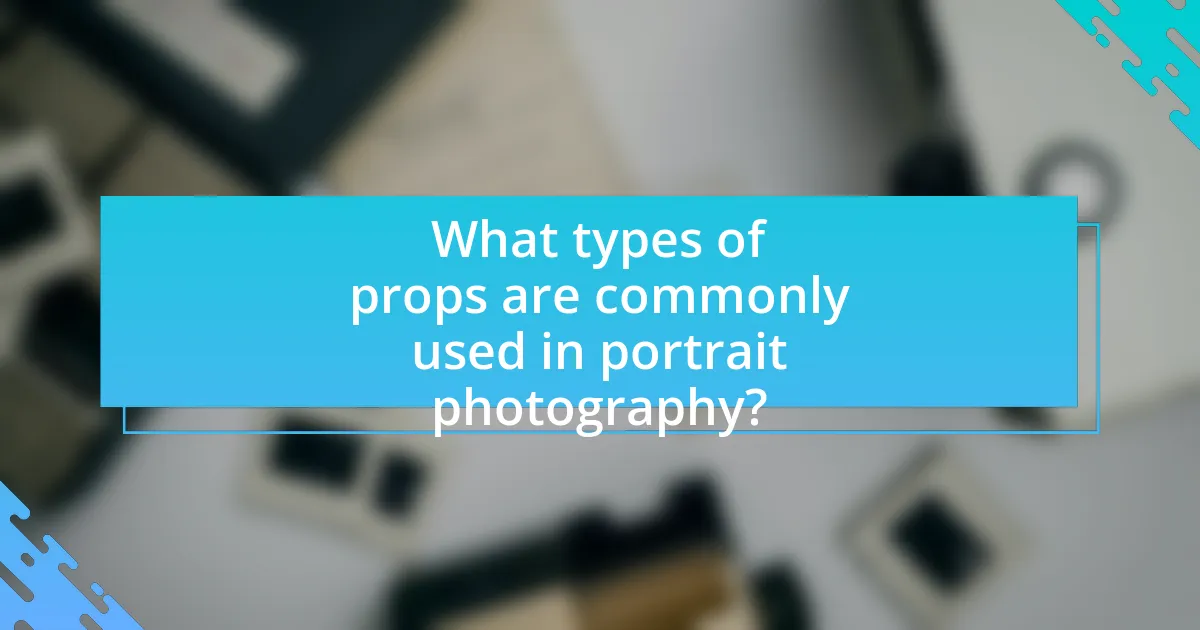
What types of props are commonly used in portrait photography?
Commonly used props in portrait photography include chairs, hats, flowers, and books. Chairs provide a versatile seating option that can enhance the subject’s posture and create a relaxed atmosphere. Hats can add personality and style, while flowers introduce color and a natural element to the composition. Books serve as intellectual props that can reflect the subject’s interests or profession. These props are frequently utilized to create context and depth in portraits, making them visually engaging and meaningful.
How can natural elements serve as props in portraits?
Natural elements can serve as props in portraits by adding depth, context, and emotional resonance to the image. For instance, incorporating flowers can symbolize beauty and fragility, while trees can evoke a sense of strength and stability. The use of natural light enhances the overall mood and highlights the subject’s features, creating a more dynamic composition. Studies in photography emphasize that integrating elements like water or foliage can lead to more engaging and visually appealing portraits, as they provide a narrative that complements the subject.
What are some examples of using flowers or plants as props?
Using flowers or plants as props can enhance portraits by adding color, texture, and emotional depth. For example, a model can hold a bouquet of vibrant roses to convey romance, while a single sunflower can symbolize happiness and warmth in a casual portrait. Additionally, incorporating greenery, such as ferns or eucalyptus, can create a natural and organic feel, complementing outdoor settings. These elements not only beautify the composition but also help convey specific themes or moods, making the portraits more engaging and visually appealing.
How do outdoor settings enhance the use of natural props?
Outdoor settings enhance the use of natural props by providing a diverse and dynamic backdrop that complements the subject. The variety of elements such as trees, rocks, and water features allows for creative integration of these props into portraits, adding depth and context. For instance, a tree can serve as a framing device, while flowers can introduce color and texture, enriching the visual narrative. Studies in photography emphasize that natural environments contribute to more authentic and engaging imagery, as they reflect the subject’s personality and surroundings, making the portraits more relatable and visually appealing.
What man-made props can enhance portrait photography?
Man-made props that can enhance portrait photography include backdrops, reflectors, and various accessories like hats or scarves. Backdrops provide a controlled environment that can complement the subject, while reflectors help manipulate natural light to create flattering highlights and shadows on the subject’s face. Accessories such as hats or scarves add personality and context to the portrait, making it more engaging. These props are widely used in professional photography to improve composition and visual interest, as evidenced by their frequent inclusion in photography tutorials and workshops.
How do clothing and accessories function as props?
Clothing and accessories function as props by enhancing the visual narrative and emotional expression in portraits. They provide context, convey personality, and can symbolize themes or ideas relevant to the subject. For instance, a vintage dress can evoke nostalgia, while modern accessories may suggest contemporary style. The strategic use of colors, patterns, and textures in clothing and accessories can also influence the mood of the portrait, guiding the viewer’s perception. Studies in visual communication highlight that attire significantly impacts first impressions, reinforcing the idea that clothing and accessories are not merely decorative but integral to storytelling in photography.
What are some creative uses of furniture in portrait settings?
Creative uses of furniture in portrait settings include utilizing chairs, sofas, and tables to create dynamic compositions and enhance storytelling. For instance, a vintage armchair can serve as a focal point, adding character and context to the subject, while a simple table can be used to display personal items that reflect the subject’s personality. Additionally, layering furniture, such as placing a stool in front of a larger piece, can create depth and visual interest in the portrait. These techniques are supported by the fact that incorporating furniture can help establish a narrative, as seen in the works of renowned photographers who often use props to convey emotions and themes in their portraits.

How can you effectively incorporate props into your portrait sessions?
To effectively incorporate props into your portrait sessions, select items that enhance the subject’s personality and the overall theme of the shoot. For instance, using a vintage chair can add character and context, while personal items like a favorite book or instrument can create a more intimate and relatable atmosphere. Research indicates that props can significantly influence the emotional tone of portraits, as they provide visual interest and storytelling elements that engage viewers. By thoughtfully choosing props that resonate with the subject, photographers can create compelling images that reflect individual stories and enhance the overall composition.
What tips can help photographers choose the right props?
Photographers can choose the right props by considering the theme and mood of the shoot, ensuring that the props complement the subject and enhance the overall composition. Selecting props that reflect the personality or story of the subject can create a more engaging image. Additionally, photographers should evaluate the color palette of the props to ensure they harmonize with the background and the subject’s attire, as contrasting colors can draw attention effectively. Practicality is also essential; props should be easy to handle and not distract from the main focus of the photograph. Research indicates that well-chosen props can significantly improve viewer engagement and emotional response, as evidenced by studies in visual communication that highlight the impact of contextual elements in photography.
How does understanding the subject’s personality influence prop selection?
Understanding the subject’s personality significantly influences prop selection by ensuring that the chosen props resonate with the subject’s character and emotional expression. For instance, a subject with a vibrant and outgoing personality may benefit from colorful and playful props, while a more introspective individual might prefer minimalist or subdued items that reflect their inner thoughts. Research in psychology indicates that personality traits, such as extroversion and openness, directly affect preferences and behaviors, which can be applied to prop selection in portrait photography. By aligning props with the subject’s personality, photographers can create more authentic and engaging portraits that capture the essence of the individual.
What considerations should be made regarding the location and props?
When selecting a location and props for portrait photography, consider the visual harmony between the subject and the environment. The location should complement the subject’s personality and the intended mood of the portrait, such as choosing a serene park for a calm demeanor or an urban setting for a vibrant, energetic feel. Additionally, props should enhance the narrative without overwhelming the subject; for instance, a musical instrument can signify a musician’s identity, while a book can reflect a reader’s passion. The lighting conditions of the location also play a crucial role, as natural light can create flattering effects, while artificial lighting may require additional equipment to achieve the desired outcome.
What are common mistakes to avoid when using props in portraits?
Common mistakes to avoid when using props in portraits include selecting props that are overly distracting, using props that do not complement the subject, and failing to consider the scale and proportion of the props in relation to the subject. Distracting props can draw attention away from the subject, undermining the portrait’s focus. Props that clash with the subject’s style or personality can create a disjointed visual narrative. Additionally, using props that are too large or too small can distort the composition, leading to an unbalanced image. These mistakes can significantly impact the effectiveness of the portrait, as they detract from the intended message and aesthetic.
How can overusing props detract from the subject in a portrait?
Overusing props in a portrait can detract from the subject by shifting the viewer’s focus away from the individual being portrayed. When props dominate the composition, they can create visual clutter, making it difficult for the audience to connect with the subject’s expression and personality. Research indicates that effective portraiture relies on a balance between the subject and their surroundings; excessive props can overwhelm the subject, leading to a disconnection in the emotional impact of the image. For instance, a study published in the Journal of Visual Communication found that images with minimal props were perceived as more engaging and emotionally resonant compared to those with numerous distracting elements.
What are the risks of using props that clash with the portrait’s theme?
Using props that clash with the portrait’s theme can lead to confusion in the viewer’s interpretation and detract from the intended message of the artwork. When props do not align with the theme, they can create visual dissonance, making it difficult for the audience to connect with the subject or narrative being portrayed. For example, a portrait intended to convey a sense of elegance may be undermined by the inclusion of casual or unrelated items, which can shift the focus away from the subject and dilute the emotional impact. This misalignment can also result in a lack of coherence in the overall composition, potentially leading to a negative reception from viewers and critics alike.
What best practices should photographers follow when using props?
Photographers should ensure that props enhance the subject and do not distract from it. Selecting props that complement the theme and mood of the shoot is crucial; for example, using vintage items for a retro-themed portrait can create a cohesive look. Additionally, maintaining a balance in size and scale between the subject and the prop is important to avoid overwhelming the subject. Proper placement of props should also be considered, as they should support the composition rather than obstruct it. Finally, photographers should test the props in advance to ensure they work well with lighting and angles, as this can significantly impact the final image quality.
How can you ensure props complement rather than overwhelm the subject?
To ensure props complement rather than overwhelm the subject, select props that enhance the subject’s features and story without drawing attention away from them. For instance, using soft colors or textures that harmonize with the subject’s clothing can create a cohesive look, while avoiding overly busy or distracting elements. Research indicates that simplicity in prop selection often leads to more impactful portraits, as evidenced by studies showing that viewers focus more on the subject when props are minimal and relevant.
What techniques can enhance the integration of props in portraits?
To enhance the integration of props in portraits, photographers can utilize techniques such as thoughtful composition, color coordination, and storytelling. Thoughtful composition involves strategically placing props to complement the subject, ensuring they do not distract but rather enhance the overall image. Color coordination between the props and the subject’s attire can create visual harmony, making the portrait more cohesive. Additionally, incorporating props that tell a story or reflect the subject’s personality can add depth and context, making the portrait more engaging. These techniques are supported by principles of visual aesthetics and narrative photography, which emphasize the importance of balance and meaning in visual storytelling.




